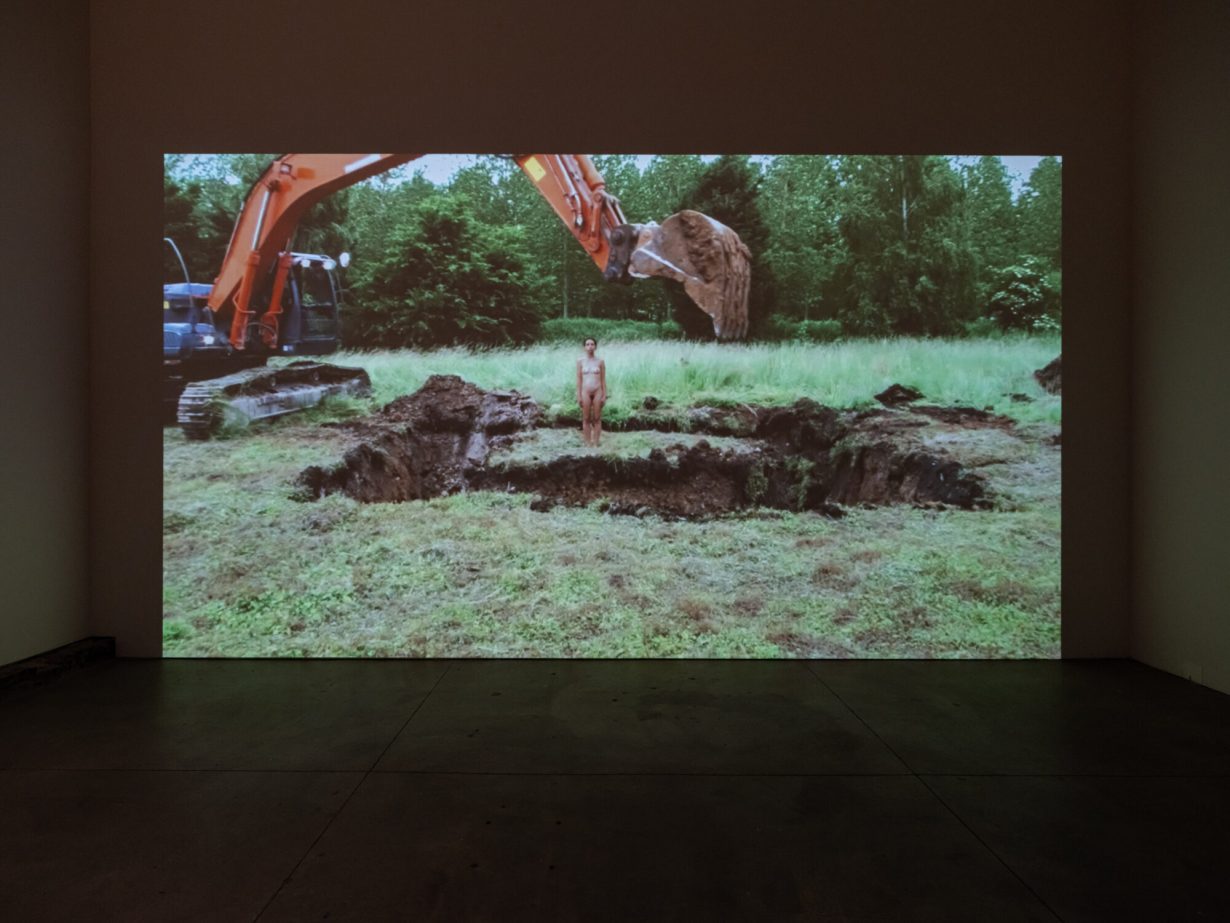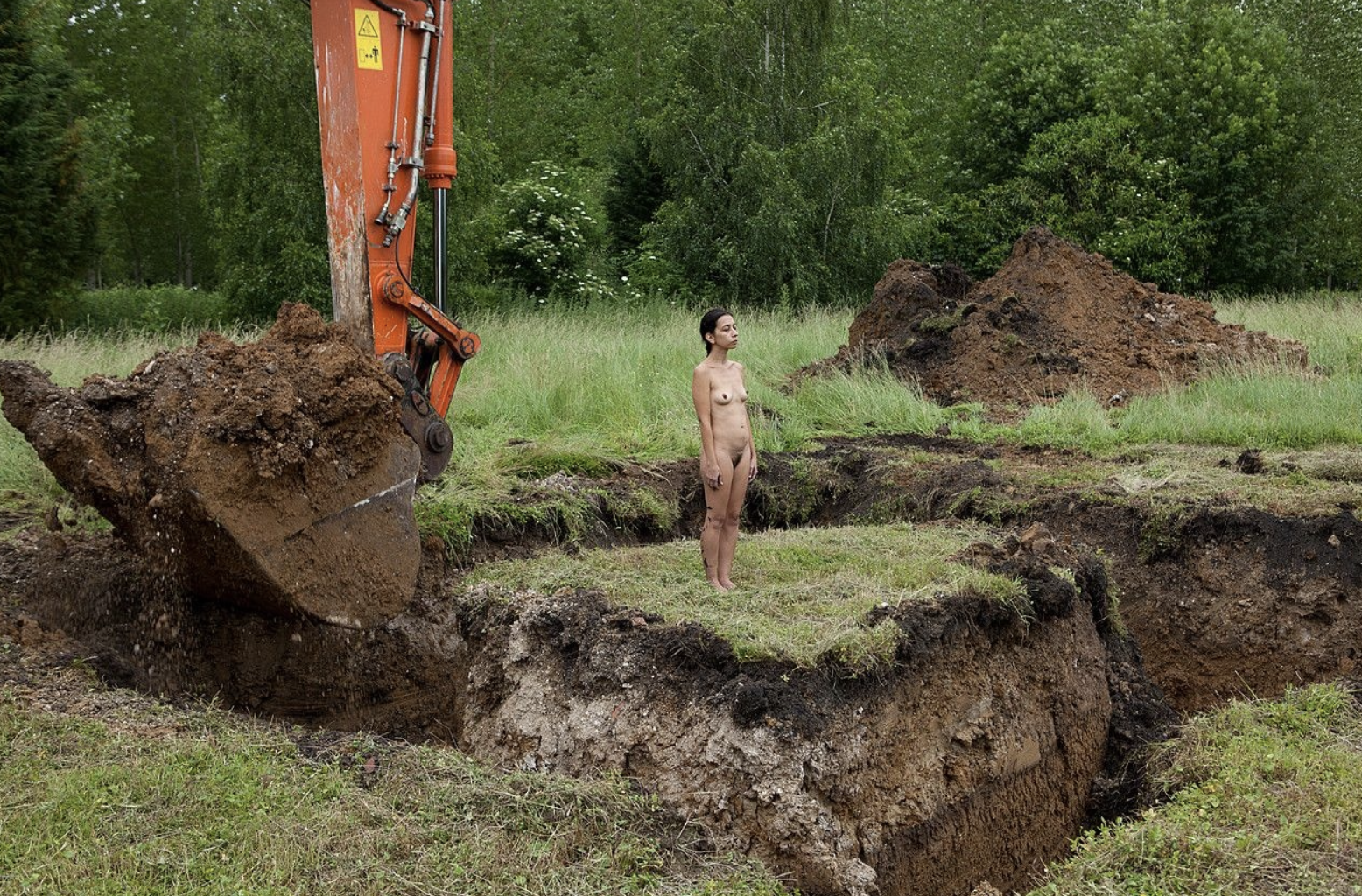In the Guatemalan artist’s Tierra (2013), currently on show at MoMA PS1 in New York, ‘land’ and ‘gender’ are both abusable resources for the technologies of conquest
It’s hard not to be hyperaware of where one stands when encountering Regina José Galindo’s videowork, Tierra (2013). In it, the artist stands naked in a field while an excavator razes the land around her, ultimately leaving her on an island of grass surrounded by a six-foot trench. At the time of the performance, the former president of Guatemala, General Efrain Rios Montt, was standing trial for crimes against humanity that included genocidal sexual violence against Maya Ixil people. I first learned about Tierra from the Museo de Arte Contemporáneo de Puerto Rico’s (MAC) 2021 show called Turned Into Sterile Land: it joined work by artists such as Ana Mendieta and las Nietas de Nonó to pay close attention to how, throughout histories of conquest and imperialism, land and women have suffered parallel forms of exploitation. Since, the colonising gaze formed categories like ‘land’ and ‘gender’ to identify them as abusable resources. Land becomes valuable for its ability to reproduce resources and women are seen as mere incubators for more colonial subjects; land becomes gendered and feminised bodies are treated like dirt.
To a Puerto Rican audience at MAC, this relationship between land and gender recalled a familiar history of ‘population control’, wherein the US government targeted women of child-bearing age for coerced or forced sterilisation as a way of tightening its colonial grip on the islands, especially in the sixties and seventies. Now at MoMA PS1, Tierra is on view for the first time since entering MoMA’s collection in 2020. The video is projected across a two-story wall and the artist’s naked body becomes a giant before the visitors circulating the room. Galindo is a slight figure, a fact of proportion she uses to her advantage in her performances. When the Guggenheim Museum exhibited the work in 2014, it noted the ‘stark contrast between the machine’s huge, armored bulk and the artist’s vulnerable body’. In her catalogue essay for the Puerto Rican exhibition, by Emilia Quiñones Otal describes how Galindo’s body, ‘a feminized and (and outside of Guatemala) radicalized body’ not only ‘problematizes the holocaust in Guatemala, but also questions the sexual and reproductive attacks that were carried out against the indigenous people of the region.’ When Galindo discussed Tierra in 2021 she described how “around me there is nothing but chaos and theft but I remain on my feet, ready to fight, ready to defend the land that roots me”.

In a sense, Tierra is also a work about technologies of conquest. It presents us with Galindo’s small tan body dwarfed by the Hitachi excavator, which circles the artist’s shrinking island of dirt like a vulture. An excavator – a machine for the swift razing of land and easy transport of materials – embodies the ‘chaos and theft’ she is ready to fight. Conquest at the devastating scale that animates Galindo as an artist is not possible without its technologies.
A name like ‘tierra’ (Spanish for dirt or Earth) shows us the land beneath our own feet; how much destruction and how many excavators were used to erect our precious museums. Quiñones Otal claims that Tierra is a work in which ‘the artist’s body is the main medium; nonetheless they were conceived solely for the camera’. But I think the inverse is truer, or at least, more important to today’s viewer. For those of us who visit museums or galleries and find ourselves in front of those modest screens or towering projections of Tierra, that is the technological intervention that matters most. The excavator only threatens to reach the artist, but the cameras actually cut through her. Any emotion, intention or breath we are able to read on her face or body is made possible by the pixels that recreate their likeness on our screens. In The Work of Art In the Age of Mechanical Reproduction (1935) Walter Benjamin writes that, ‘the sight of immediate reality has become an orchid in the land of technology’. Galindo’s performance is excavated by the cameras, recorded onto film or memory cards, edited into shots then reconstituted on screens and through projectors. Tierra is no orchid of the land Benjamin describes, nor is it immediate. Indeed, the experience of viewing Tierra parallels the very processes of excavation and extraction Galindo criticises in the work.

Through Tierra’s thirty-minute duration we see the artist head-on, from a distance, then close-up, and sometimes from the side. Two camaramen, each with their own camera, recorded the performance in one take. We see what they saw and nothing else. Our ability to survey Tierra’s entire scene, to get close enough to excavator to read its branding, to meet Galindo’s face up-close or from the side, to step away after it’s all over without falling into the trench – as we were in the very air that surrounds her – comes from the use of those cameras, the excavation and reconstruction of that performance by the assembly of image-making technologies.
As naturalised as this all-seeing perspective has become, it’s far from neutral. While Tierra aims to commemorate a history, it also relies on its same illusions of omnipresence. Donna Haraway calls it the ‘god trick’, the illusion of objectivity that ‘offers visibility from everywhere and nowhere’, she wrote in her essay ‘Situated Knowledges’ (1988). The god trick is that pesky quirk of the colonising gaze that positions us outside of the histories Galindo memorialises in Tierra. It reproduces itself in our knowledges and technologies to ‘leap out of the marked body and into the conquering gaze from nowhere’. Haraway found the god trick in the very sciences that justified the literal conquests of land and the subjugation of its people. It’s that very same god trick that established ‘land’ and ‘women’ as categories of exploitable resources. The god trick is what convinces us that we saw everything there is to see in Tierra and that our own two feet are excluded from the story it tells.
Plenty has of course been written about the camera’s impetus to capture; the violence of its shooting; its ability to design perspectives that render its own mechanisms, the feet on its tripod, invisible. This is where the colonising gaze comes from, this is how land and bodies are formulated to be equally exploitable. My use of passive voice here does similar work to that of the camera that recorded Tierra – concealing the doers, those who look, categorise or exploit their immediate surroundings.
Tierra is not a witness or a document, but something far more partial: a perspective. One of many. Galindo stands on her feet, defending the land that roots her. But the videowork also shows us where we stand, how the ground below us became covered in pavement, tall buildings and air-conditioned rooms. It asks us to consider how our bodies are marked by gender, race, and class; and how, in our own lives, we play the role of the excavator or the person behind the camera, or we stand in the artist’s own two feet. Body and land are what situate us, Galindo reminds us. Without them, we are nobody and nowhere.
Michelle Santiago Cortés is a writer and critic living and working in Brooklyn, New York. She writes essays about digital culture and life online, as well as works of criticism about art and technology.
